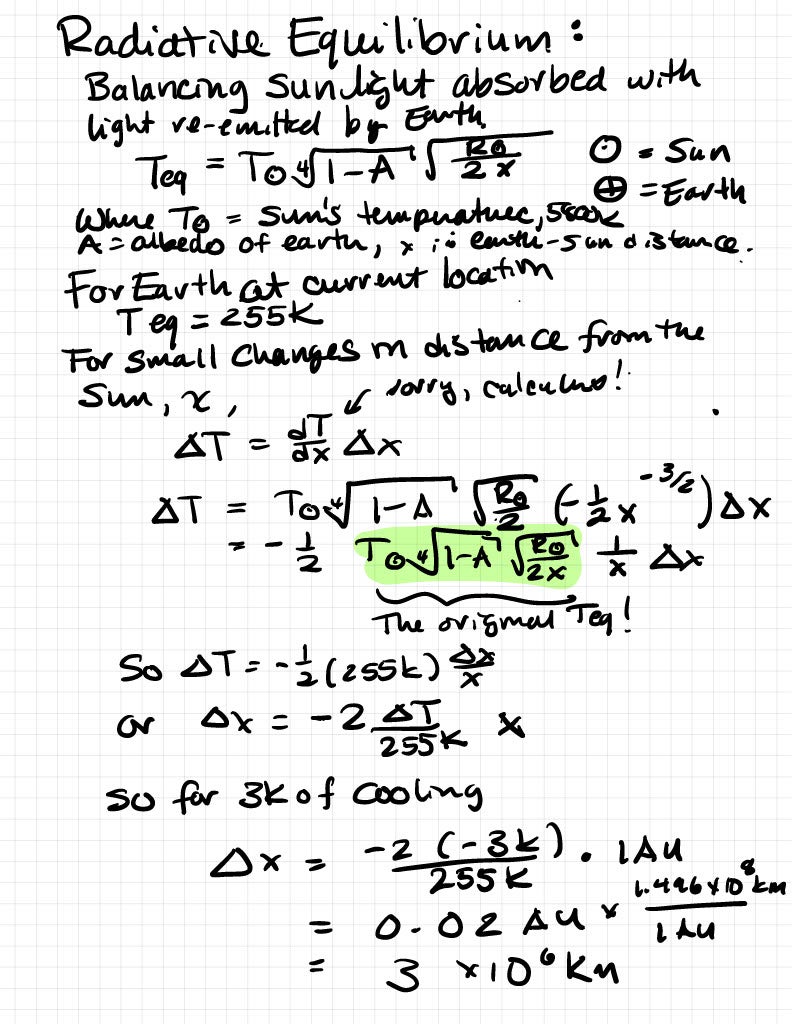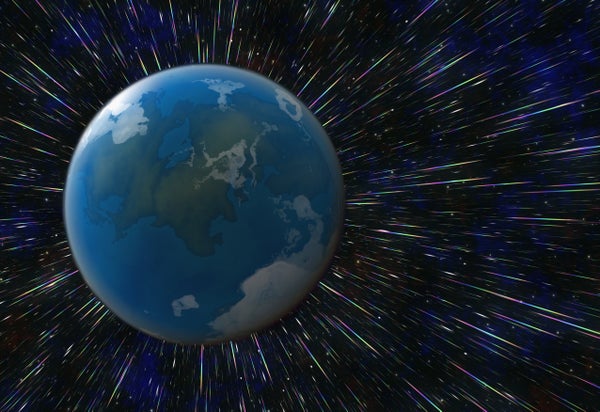During a congressional hearing last week, Republican Representative Louie Gohmert of Texas asked a U.S. Forest Service official if her organization or the Bureau of Land Management could change the orbit of the moon or Earth to reverse the effects of human-caused climate change. That seems like a perfectly reasonable idea, doesn’t it? Let’s do it.
First, we must take stock of what we have—the givens in what will be our equation for moving Earth. Our planet orbits the sun at an average distance of 149.6 million kilometers, and it soaks up enough sunlight to have an average temperature of about 15 degrees Celsius. The latter figure is, however, an increase of slightly more than one degree C from Earth’s typical temperature across the past century. In short, this world is running a low-grade fever. According to current consensus estimates, that fever is likely to get much worse if left unchecked, raising Earth’s average temperature by another one degree C by the 2060s. Such an increase would render some presently people-packed parts of the planet effectively uninhabitable and threaten the sustainability of global civilization as we know it.
Radiative equilibrium, the balance between incoming energy from the sun’s rays and energy emitted from Earth, is key to our understanding of our planet’s changing temperature, says Britt Scharringhausen, a planetary astronomer atBeloit College. It is described in the following equation, as scribbled out by Scharringhausen.
On supporting science journalism
If you're enjoying this article, consider supporting our award-winning journalism by subscribing. By purchasing a subscription you are helping to ensure the future of impactful stories about the discoveries and ideas shaping our world today.

Page from planetary astronomer Britt Scharringhausen’s lab notebook shows a handwritten equation for determining a planet’s radiative equilibrium (highlighted in green), which sets its effective temperature. Credit: Britt Scharringhausen
Here, Teq is Earth’s temperature, T☉ is the sun’s temperature, R☉ is the sun’s radius, X is the distance to the sun, and A is Earth’s albedo, or reflectivity.* Albedo measures how well our planet reflects solar energy, where 0 would be perfect absorption and 1 would be perfect reflection. There is a connection between climate change and albedo: snow and ice, for instance, have a high albedo, reflecting up to 90 percent of the sunlight that hits them back to outer space. Anthropogenic warming causes snow and ice caps to melt, which can make Earth’s albedo decrease. That, inturn, eventually leads toa higher average planetary temperature.
Some variables in this equation are changing naturally. Our star is very slowly swelling and brightening, becoming slightly larger and more luminous as it ages. Ethan Siegel, a theoretical astrophysicist and science writer, says that while it will take the sun on the order of 100 million years to increase in luminosity by 1 percent, our greenhouse-gas-emitting global civilization is projected to increase the solar energy retained by Earth by 1 percent over the next few hundred to 1,000 years.
To make Earth cooler, we need to decrease a variable on the right side of the equation: We can’t easily lower the sun’s temperature or radius—and clearly meaningful reductions to our heat-trapping, albedo-shifting greenhouse gas emissions are out of the question. So let’s take Representative Gohmert’s advice and simply increase X, the distance to the sun. All we have to do is find a way to move all 5.972 septillion kilograms of Earth’s mass farther away from our star. Easy, right?
By Scharringhausen’s calculations, a three-degree-C decrease in temperature to counteract current and near-future anthropogenic warming would require us to move our planet an additional three million kilometers from the sun. Using another back-of-the-envelope calculation, Scharringhausen finds that 5 x 1031 joules could push all 5,972,000,000,000,000,000,000,000 kilograms of Earth’smass three million kilometers out from its present orbit. These numbers present challenges for Representative Gohmert’s plan because annual global electricity production is around 1019 joules,or 0.0000000000002 percent of what we’d need to move the globe. That’s also assuming we can apply all that energy to Earth at 100 percent efficiency, which, thanks to the laws of thermodynamics, is physically impossible.
Setting aside such particulars, we haven’t addressed what form this applied energy would take. There is the literal nuclear option: one method that scientists have proposed to move an asteroid is to detonate a nuclear bomb near it, Scharringhausen says. “It will basically vaporize part of the asteroid, and that escaping rock vapor acts like rocket exhaust and will push the asteroid along,” she explains.
Scaled up, such a mechanism could, in principle, provide enough oomph to shift a planet’s orbit. Still, it would take a billion times more nuclear explosions than we have ever set off to move Earth the required distance, or the equivalent of dropping an atomic bomb every second for 500 years, according to Geza Gyuk, director of astronomy at the Adler Planetarium in Chicago. The strategy of constantly detonating nuclear bombs near Earth’s surface with the goal of vaporizing parts of it to act as rocket exhaust also has several drawbacks. For our purposes, the most notable deleterious effect is that the blasts themselves would heat up the planet, counteracting the stated goal of reversing global warming.
A gentler option would be to siphon off the energy of other celestial objects, such as passing asteroids or comets, by engineering close planetary flybys. This technique is regularly used in reverse, with great success, by spacecraft that boost their speed by passing close to a planet to steal a portion of its orbital energy.For moving our planet, the issue with the method is scale, Siegel says: the total mass of the asteroid belt is only 4 to 5 percent of that of the moon, or 0.05 to 0.06 percent of that of Earth. Using the mass of the entire asteroid belt in flybys would migrate Earth away from the sun by less than 748,000 kilometers, or a quarter of the distance we’d need, he says. And a single off-course collision with our planet would spark destruction approaching that caused by the asteroid impact that eradicated the dinosaurs in a global mass extinction.
Fortunately, we have a much more massive space rock sitting in our backyard: the moon itself. Could we “cut” the gravitational string connecting the moon to the Earth, thereby slingshotting our planet into a wider orbit? Not in any way that we’re capable of doing today, Siegel says, and the consequences would be disastrous. Besides having greatly reduced tides, a moonless Earth would have much darker nights, shorter days and extreme, unpredictable seasons because of a destabilized axis of rotation.
What if instead of getting rid of our natural satellite altogether, we only change its orbit around Earth? Increasing the radius of the moon’s orbit by 10 percent would affect Earth’s own trajectory around the sun in the long term, says Matteo Ceriotti, a rocket scientist at the University of Glasgow’s James Watt School of Engineering.
We could extract and accelerate material off the moon, Ceriotti says. Using a 100-gigawatt laser, or one with about the power capacity of every single wind turbine in the U.S., it would take 300 trillion years to lift sufficient amounts of material from the lunar surface. There is always the aforementioned nuclear option, too, which could be used to move the moon rather than Earth. Another, less messy choice would be to manually extract lunar material with conventional rockets.
“If we were able to build a spaceport on the moon and build a rocket equivalent to SpaceX’s Falcon Heavy to lift off moon material into deep space, we would need 7 x 1016 launches,” Ceriotti says. That’s 70,000 trillion rocket launches. For comparison, during the entirety of the space age, humankind has only managed to achieve 70,780 launches, and more than half of them did not leave Earth’s atmosphere.
Humans could add a twist to the use of asteroids in the flyby idea and instead put them on a collision course with the moon, Gyuk says. We would need kilometer-sized comets to crash into the moon every second for a couple of hundred years to make a substantial difference. Again, though, an off-course projectile could cause a planetary mass extinction event.
Because of the magnitude of the change necessary to increase the Earth’s orbit, any intervention would probably need to last for many millions of years at minimum, which raises an unexpected sociological issue, Gyuk says: We don’t have precedent for planning across such vast timescales. And in fact, no civilization in human history has endured more than a mere few thousand years.
Finally, even if humans managed to alter our planet’s orbit using any of these methods, they wouldn’t be able to rest easy, Siegel says. “If we even somehow could make this enormous change in Earth’s orbit,” he says, “it doesn’t absolve us from the responsibility that we’ll keep needing to make this change as long as we keep increasing the greenhouse gas concentration in our atmosphere.”
To my ears, that sounds like a stirring endorsement of our fossil-fuel-addicted status quo! We should immediately prioritize pouring all our energy into changing Earth’s orbit, starting now and lasting forever. Sure, it’s a Sisyphean task in which humanity is Sisyphus and the boulder being eternally pushed uphill is Earth itself. But at least we’d get to keep driving our sweet SUVs! I say we get to work.
*Editor’s Note (7/18/21): This sentence was revised after posting to better align with the symbols given in the image.
